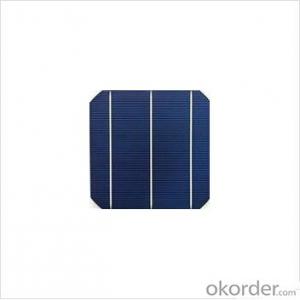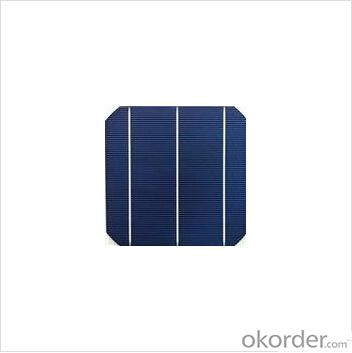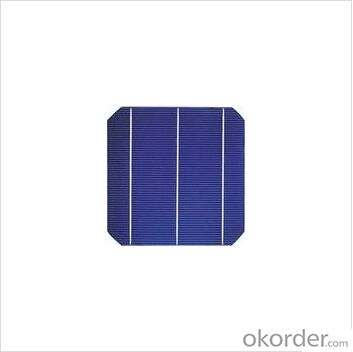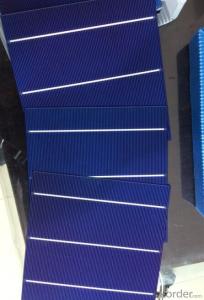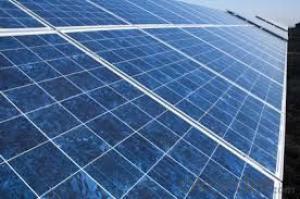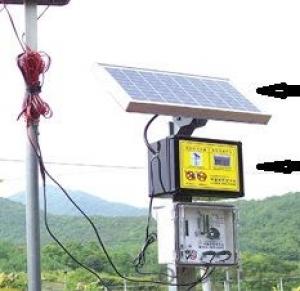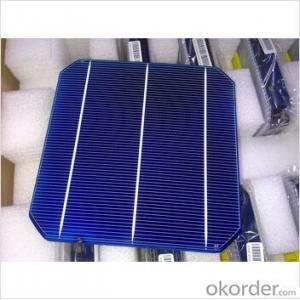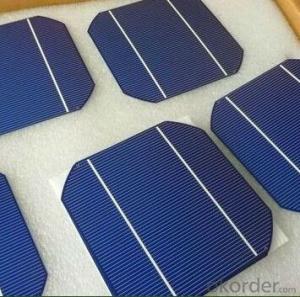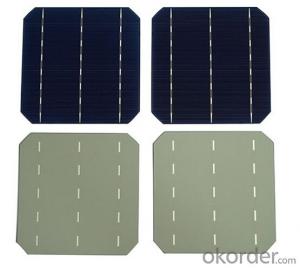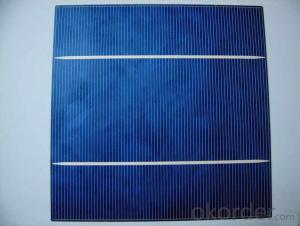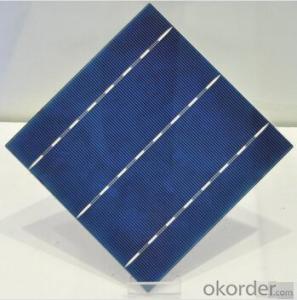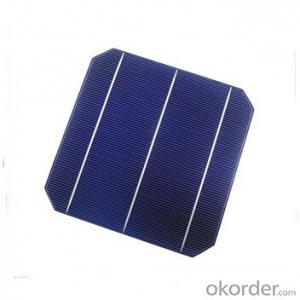High Quality 18.6 Monocrystalline Solar Cells Layers
- Loading Port:
- Shanghai
- Payment Terms:
- TT OR LC
- Min Order Qty:
- 1000 pc
- Supply Capability:
- 1000000 pc/month
OKorder Service Pledge
OKorder Financial Service
You Might Also Like
Solar Cells:
solar cells, when struck by photons of light from the sun, generates an electrical current which can then be used to power DC or AC electrical loads.
A solar cell is made of silicon. Computer chips are made of this same material. Basically, when light strikes the surface of a solar cell some of it is absorbed into the silicon. This light energy bumps the electrons loose and causes energy to flow
Solar cells is made by solar wafer, it has three categories of solar cell right now, monocrystalline polycrystalline and thin film,These cells are entirely based around the concept of PN junction, which is the critical part of solar module, it is the part that can convert the light energy into electricity, the thickness is from 180um to 200um, with even busbars to conduct electricity, textured cell can decrease diffuse reflection; they are often electrically connected and encapsulated as a module. Photovoltaic modules often have a sheet of glass on the front (sun up) side, allowing light to pass while protecting semiconductor wafers from abrasion and impact due to wind-driven debris, rain, hail, etc. Solar cells are also usually connected in series in modules, creating an additive voltage. Connecting cells in parallel will yield a higher current;With high quality and stable quality. Our Cells can greatly improve the performance of Solar Modules.
Features:
High efficiencies up to 16.4%
Proven long term mechanical stability of silicone
Make of highly purified poly silicone
Three bus bars for reduced series resistance and improved module and cell efficiency
Blue anti-reflecting coating ensures improved light absorption and increased efficiency
Acid texturization offers a uniform appearance and virtually invisible crystal structure
Excellent low light behavior for improved energy yield
Specifications
Efficiency code | 1800 | 1820 | 1840 | 1860 | 1880 | 1900 | 1920 | 1940 | 1960 | 1980 | 2000 |
Efficiency(min(%) | 18.0 | 18.2 | 18.4 | 18.6 | 18.8 | 19.0 | 19.2 | 19.4 | 19.6 | 19.8 | 20.0 |
Pmax (W) | 4.30 | 4.35 | 4.40 | 4.44 | 4.49 | 4.54 | 4.59 | 4.64 | 4.68 | 4.73 | 4.78 |
Voc (V) | 0.630 | 0.632 | 0.634 | 0.636 | 0.638 | 0.640 | 0.642 | 0.643 | 0.645 | 0.647 | 0.649 |
Isc (A) | 8.74 | 8.78 | 8.80 | 8.83 | 8.87 | 8.93 | 8.98 | 9.04 | 9.10 | 9.16 | 9.23 |
Imp (A) | 8.27 | 8.37 | 8.44 | 8.49 | 8.55 | 8.61 | 8.67 | 8.73 | 8.79 | 8.85 | 8.91 |
Solar Cells Advantage:
1. High efficiency and High power.
2. Long-term electrical stability.
3. Lowest price and Fastest delivery.
4. Good quality and good service.
5.Bulk supply
6. Good Warranty
7.Big Sale
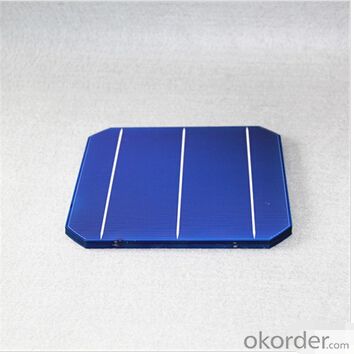
FAQ
We have organized several common questions for our clients,may help you sincerely:
1, What’s price per product ?
A: It’s depends on the quantity, delivery date and payment terms of the order. We can talk further about the detail price issue. Our products is high quality with lower price level.
2, How to make payment?
We accept T/T or L/C.
3, What is your lead time?
Generally 1-5 weeks depends on the order quantity and your specific requirements.
4, Can you do OEM for us?
Yes, we can.
5, How do you pack your products?
We have rich experience on how to pack the panels to make sure the safety on shipment when it arrives at the destination.
- Q: Can solar cells be used in indoor lighting applications?
- Yes, solar cells can be used in indoor lighting applications. However, their effectiveness may vary depending on the amount of sunlight available indoors.
- Q: Can solar cells be damaged by hail or other weather events?
- Yes, solar cells can be damaged by hail or other severe weather events. Hailstones can potentially crack or shatter the surface of the solar panels, affecting their efficiency and functionality. Similarly, extreme weather events like hurricanes or heavy storms can cause physical damage by dislodging or breaking the panels, leading to a decrease in their performance. It is important to ensure proper installation and maintenance to minimize the risk of weather-related damage to solar cells.
- Q: Can solar cells be used in traffic management systems?
- Yes, solar cells can be used in traffic management systems. Solar cells can be integrated into traffic lights, road signs, and other traffic management devices to power them using renewable energy. This helps reduce dependence on the traditional electrical grid, lowers energy costs, and promotes sustainability in traffic management systems.
- Q: Can solar cells generate power at night?
- No, solar cells cannot generate power at night as they rely on sunlight to produce electricity.
- Q: How do solar cells perform in different temperature ranges?
- Solar cells generally perform better in cooler temperatures. As the temperature increases, the efficiency of solar cells tends to decrease. However, the actual performance can vary depending on the specific type of solar cell and its design.
- Q: Do solar cells work in cloudy weather?
- Yes, solar cells can still generate electricity in cloudy weather, although their efficiency may be reduced compared to direct sunlight.
- Q: What is the role of maximum power point tracking in solar cell systems?
- The role of maximum power point tracking (MPPT) in solar cell systems is to optimize the energy output of the solar cells. It does this by continuously adjusting the operating voltage and current of the solar cells to find the maximum power point, where the solar cells are operating at their highest efficiency. MPPT ensures that the solar cells are always delivering the maximum amount of power to the system, resulting in improved energy generation and increased overall system performance.
- Q: Can solar cells be used in oil and gas exploration?
- Solar cells can indeed be used in oil and gas exploration. They can be employed to power various equipment and devices used in exploration, such as remote monitoring systems, sensors, and data collection devices. Solar cells offer a sustainable and reliable energy source in remote locations where access to traditional power grids might be challenging. Additionally, their low maintenance requirements and environmental friendliness make them an attractive option for the oil and gas industry.
- Q: What materials are used in solar cells?
- The most common materials used in solar cells are silicon, which is the primary component, along with other materials like metal conductors, glass, and polymers.
- Q: Can solar cells generate enough electricity to power an entire house?
- Yes, solar cells have the ability to generate enough electricity to power an entire house. The size and efficiency of the solar panel system, along with the energy consumption of the house, are important factors in determining if it can meet the household's electricity needs. However, with advancements in technology and larger solar installations, it is increasingly possible for solar cells to generate sufficient electricity to power a house.
Send your message to us
High Quality 18.6 Monocrystalline Solar Cells Layers
- Loading Port:
- Shanghai
- Payment Terms:
- TT OR LC
- Min Order Qty:
- 1000 pc
- Supply Capability:
- 1000000 pc/month
OKorder Service Pledge
OKorder Financial Service
Similar products
Hot products
Hot Searches
Related keywords
